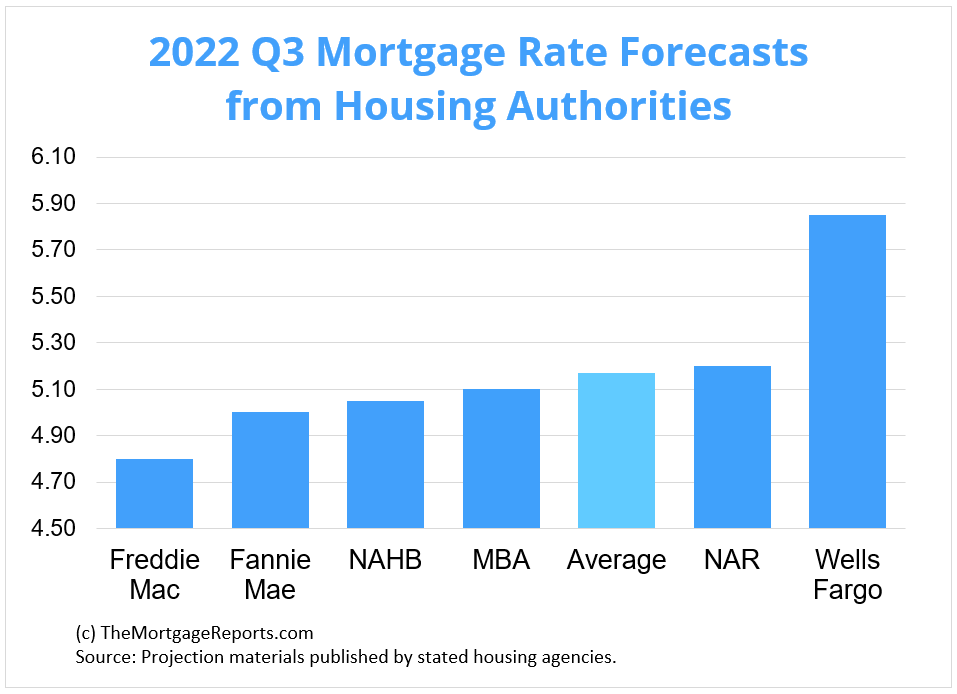Mortgage rate forecast for next week (July 25-29)
Mortgage rates continued their rollercoaster ride through July and took another big leap after a huge drop off.
The average 30-year fixed interest rate jumped from 5.30% on July 7 to 5.51% on July 14, according to Freddie Mac.
The recent volatility can be attributed to the opposing forces of decades-high inflation and a slowing economy pulling them in different directions. The next move for mortgage rates will likely depend on whether the need to offset inflation outweighs recession worries or vice versa.
Find your lowest mortgage rate. Start here (Jul 19th, 2022)
In this article (Skip to…)
>Related: Cash-out refinance: Best uses for your home equity
Will mortgage rates go down in July?
Mortgage rates surged in the first half of 2022, with the average 30-year fixed rate growing by 248 basis points (2.48%) from Jan. 6 to June 30, according to Freddie Mac.
Rates mostly fluctuated through the second quarter until the Federal Reserve’s June hike to combat inflation. The day after, mortgage interest rates experienced the largest week-over-week jump — 55 basis points, or 0.55% — since 1987.
With the pandemic’s declining economic impact, inflation running at 40-year highs, and the Fed planning four more aggressive hikes, interest rates could continue trending upward this year.
However, concerns over an impending recession have caused rate drops and could cause more on any given week.
Experts from Fannie Mae, First American and other industry leaders are split on whether 30-year mortgage rates will keep climbing in July or level off.
“The market should expect rate volatility in a tight range, similar to the energy and momentum of a yo-yo as it unwinds and rewinds.”
—Paul Buege, president and CEO of Inlanta Mortgage
Paul Buege, president and CEO of Inlanta Mortgage
Prediction: Rates will rise
“Mortgage rates will likely move up over the next 30 days. The market should expect rate volatility in a tight range, similar to the energy and momentum of a yo-yo as it unwinds and rewinds. Thirty-year fixed mortgage rates will increase another 0.25% to 0.375% through July and settle in at around 6.5 percent. Comments from any of the seven members of the Board of Governors of the Federal Reserve System over the next 30 days will be hyper-analyzed for clues into what the Fed’s July rate hike will be.
The markets have already factored in an increase of no less than 50 basis points and a larger increase will produce mortgage rates over 6.5 percent. The Fed will be looking for multiple signals that inflation is beginning to ease. Key economic indicators to watch will be the gross domestic product (GDP), employment figures, consumer spending and inflation.”
Doug Duncan, chief economist at Fannie Mae
Prediction: Rates will rise
“The Fed will raise their rate at least 50 basis points and possibly another 75 in July, and I think they’ll raise it again in September. Depends on what they see in the market between now and then with the inflation measures. Mortgage rates are going to be at least at 6 percent.
Markets are efficient and will adjust for the available information. Interest rates will go up until the market perceives something’s broken, and there’s going to be a recession, and then they’ll start going down when the Fed eases.”
Brian Koss, executive vice president at Mortgage Network
Prediction: Rates will rise
“With the potential for three to four additional rate hikes totaling 1.5% from the Federal Reserve over the next few months, we expect rates to be topping out at 0.5% above recent highs, or slightly higher. Rates will stay elevated until the market believes inflation has been controlled.
Rallies in the market will be dictated by the recession narrative—how severe it will be and how long it will last. Our hope, however, is that the Fed’s proactive measures will help calm investors, so we can get past this situation more quickly and see rates start to move lower in the future.”
Odeta Kushi, deputy chief economist at First American
Prediction: Rates will fall
“Mortgage rates surged to their highest level since 2008 following the Fed’s decision to hike its benchmark federal funds rate by a greater-than-anticipated 75 basis points. Markets have already priced in much of the monetary tightening from the Fed, so the pace of mortgage rate increases should stabilize in upcoming months.
“If fears of a recession grow, it may prompt a flight to safety in U.S. Treasury bonds, which may put downward pressure on mortgage rates.”
–Odeta Kushi, deputy chief economist at First American
However, if inflation surprises to the upside, the Fed will likely take more aggressive action and mortgage rates will climb faster as a result. The other factor that may come into play are recession fears. If fears of a recession grow, it may prompt a flight to safety in U.S. Treasury bonds, which may put downward pressure on mortgage rates.”
Preetam Purohit, head of hedging and analytics at Embrace Home Loans
Prediction: Rates will fall
“Mortgage lenders have started to face more margin pressure as they compete for fewer and fewer loans. The Russia-Ukraine war will keep a floor on gas prices. We also expect rents to remain higher to match the increase in home prices. With this background and the expectation that the Federal Open Markets Committee (FOMC) will increase the fed fund rates by another 75 basis points in July to compensate for its delayed response to inflation, we expect the economy to slow down.
This economic slowdown will put pressure on the belly and the longer end of the yield curve, which determines mortgage rates. Rates should peak at 6% for a no-point mortgage and we should see mortgage rates stabilize at these levels and then gradually go down 50 basis points over the rest of summer.”
Get started shopping for mortgage rates (Jul 19th, 2022)
Mortgage interest rates forecast next 90 days
Outside of the uncertainty surrounding the Russian-Ukrainian war or possible new Covid restrictions slowing the economy, the Federal Reserve’s aggressive rate hike plan points toward further mortgage rate growth.
In all likelihood, average interest rates will increase over the next three months. Of course, mortgage rates tend to be volatile so we could see some drops mixed in as well.
Mortgage rate predictions for 2022
The average 30-year fixed-rate mortgage ended the first quarter of 2022 at 4.67%, according to Freddie Mac.
All six of the major housing authorities we gathered project the average for the third quarter to go above that.
Freddie Mac and Fannie Mae sit at the low end of the group, estimating the average 30-year fixed interest rate will settle at 4.8% or 5% by the end of Q3. Wells Fargo had the highest prediction, with a forecast of 5.85% by the end of September. However, most of these are likely low because they were made prior to the Federal Reserve’s latest hike and subsequent spike in mortgage rates.
| Housing Authority | 30-Year Mortgage Rate Forecast (Q3 2022) |
| Freddie Mac | 4.80% |
| Fannie Mae | 5.00% |
| National Association of Home Builders | 5.05% |
| Mortgage Bankers Association | 5.10% |
| National Association of Realtors | 5.20% |
| Wells Fargo | 5.85% |
| Average Prediction | 5.17% |
Get started shopping for mortgage rates (Jul 19th, 2022)
Current mortgage interest rate trends
Mortgage rates have experienced big swings over the past month, with growth accounting for the latest movements.
The average 30-year fixed rate jumped from 5.30% to 5.51% for the seven days ending July 7, according to Freddie Mac’s weekly rate survey.
Similarly, the 15-year fixed rate rose from 4.45% to 4.67%, and the average rate for a 5/1 ARM went from 4.19% to 4.35%.
| Month | Average 30-Year Fixed Rate |
| June 2021 | 2.98% |
| July 2021 | 2.87% |
| August 2021 | 2.84% |
| September 2021 | 2.90% |
| October 2021 | 3.07% |
| November 2021 | 3.07% |
| December 2021 | 3.10% |
| January 2022 | 3.45% |
| February 2022 | 3.76% |
| March 2022 | 4.17% |
| April 2022 | 4.98% |
| May 2022 | 5.23% |
Source: Freddie Mac
Mortgage rates moved on from the record–low territory seen in 2020 and 2021 but are still low from a historical perspective.
Dating back to April 1971, the fixed 30–year interest rate averaged 7.79%, according to Freddie Mac.
So if you haven’t locked a rate yet, don’t lose too much sleep over it. You can still get a great deal — especially if you’re a borrower with strong credit.
Just make sure you shop around to find the best lender and lowest rate for your unique situation.
Mortgage rate trends by loan type
Many mortgage shoppers don’t realize there are different types of rates in today’s mortgage market.
But this knowledge can help home buyers and refinancing households find the best value for their situation.
Following are 3–month mortgage rate trends for the most popular types of home loans: conventional, FHA, VA, and jumbo.
| May 2022 | April 2022 | March 2022 | |
| Conforming Loan Rates | 5.34% | 5.42% | 4.79% |
| FHA Loan Rates | 5.25% | 5.28% | 4.81% |
| VA Loan Rates | 4.95% | 5.08% | 4.57% |
| Jumbo Loan Rates | 4.92% | 4.89% | 4.37% |
Source: Black Knight Originations Market Monitor Report
Which mortgage loan is best?
The best mortgage for you depends on your financial situation and your goals.
For instance, if you want to buy a high–priced home and you have great credit, a jumbo loan is your best bet. Jumbo mortgages allow loan amounts above conforming loan limits, which max out at $647,200 in most parts of the U.S.
On the other hand, if you’re a veteran or service member, a VA loan is almost always the right choice.
VA loans are backed by the U.S. Department of Veterans Affairs. They provide ultra-low rates and never charge private mortgage insurance (PMI). But you need an eligible service history to qualify.
Conforming loans and FHA loans (those backed by the Federal Housing Administration) are great low–down–payment options.
Conforming loans allow as little as 3% down with FICO scores starting at 620.
FHA loans are even more lenient about credit; home buyers can often qualify with a score of 580 or higher, and a less–than–perfect credit history might not disqualify you.
Finally, consider a USDA loan if you want to buy or refinance real estate in a rural area. USDA loans have below-market rates — similar to VA — and reduced mortgage insurance costs. The catch? You need to live in a ‘rural’ area and have moderate or low income to be USDA–eligible.
Find your lowest mortgage rate. Start here (Jul 19th, 2022)
Mortgage rate strategies for July 2022
Mortgage rates grew rapidly and significantly to open 2022. The pace slowed in the second quarter, then interest rates shot up after the Fed’s 0.75% federal funds rate hike in mid-June. The central bank said it anticipates similar hikes four more times in 2022, with the next one coming at the end of July. In all likelihood, mortgage rates will climb throughout the rest of the year. However, opportunities to lock in a low interest rate do still exist for home buyers and refinancing homeowners.
Here are just a few strategies to keep in mind if you’re mortgage shopping in the next few months.
Find a cheap way to buy a home
Home prices grew at astronomical levels over the past few years. And in 2022, mortgage rates shot up rapidly and are expected to continue climbing. It all adds up to diminished affordability for potential home buyers.
However, work-arounds to find a cheap house exist — or cheap ways to finance one. There are always low and no down payment loans, as well as down payment assistance programs to explore. You could also talk to your lender about an adjustable-rate mortgage, which can be advantageous in a growing rate environment.
So before believing you’re destined to rent forever, reach out to a loan officer or mortgage expert for tips and tricks for home buying in today’s extreme seller’s market.
Put yourself in the driver’s seat for interest rates
The Federal Reserve made its largest federal funds rate hike since 1994 at its June meeting and anticipates similar hikes at its four remaining meetings this year. Interest rates surged immediately following the action and it’s reasonable to expect that could happen again if more hikes materialize.
Because of these higher rates, lenders have less business from home buyers and fewer borrowers trying to refinance. This means they are more likely to offer better rates than their competition. Make sure to have all your paperwork ready for approval and then shop your rate to multiple lenders.
How to shop for interest rates
Rate shopping doesn’t just mean looking at the lowest rates advertised online because those aren’t available to everyone. Typically, those are offered to borrowers with perfect credit and who can put a down payment of 20% or more.
The rate lenders actually offer depends on:
- Your credit score and credit history
- Your personal finances
- Your down payment (if buying a home)
- Your home equity (if refinancing)
- Your loan-to-value ratio (LTV)
- Your debt-to-income ratio (DTI)
To figure out what rate a lender can offer you based on those factors, you have to fill out a loan application. Lenders will check your credit and verify your income and debts, then give you a ‘real’ rate quote based on your financial situation.
You should get three to five of these quotes at a minimum. Then compare them to find the best offer.
Look for the lowest rate, but also pay attention to your annual percentage rate (APR), estimated closing costs, and ‘discount points’ — extra fees charged upfront to lower your rate.
This might sound like a lot of work. But you can shop for mortgage rates in under a day if you put your mind to it. And shaving just a few basis points off your rate can save you thousands.
Compare mortgage and refinance rates. Start here (Jul 19th, 2022)
Mortgage interest rate FAQ
Current mortgage rates are averaging 5.51% for a 30–year fixed–rate loan, 4.67% for a 15–year fixed–rate loan, and 4.35% for a 5/1 adjustable–rate mortgage, according to Freddie Mac’s latest weekly rate survey. Your individual rate could be higher or lower than the average depending on your credit score, down payment, and the lender you choose to work with, among other factors.
Mortgage rates could decrease next week (July 25-29, 2022) if the mortgage market takes a cautious approach to a possible recession on the horizon. However, rates could rise if the high inflation of 2022 keeps up and needs to be reigned in.
It’s unlikely mortgage rates will go down in 2022. Inflation has been climbing at a record rate over the last few months. And the Fed is planning to raise interest rates after each of its scheduled FOMC meetings. Both these factors should lead to significantly higher mortgage rates in 2022.
Yes, it’s very likely mortgage rates will increase in 2022. High inflation, a strong housing market, and policy changes by the Federal Reserve should all push rates higher in 2022. The only thing likely to push rates down would be a major resurgence in serious Covid cases and further economic shutdowns. But, while it could help mortgage rates, no one is hoping for that outcome.
Freddie Mac is now citing average 30-year rates in the 5 percent range. If you can find a rate in the 4s, you’re in a very good position. Remember that rates vary a lot by borrower. Those with perfect credit and large down payments may get below-average interest rates, while poor-credit borrowers and those with non-QM loans could see much higher rates. You’ll need to get pre-approved for a mortgage to know your exact rate.
For the most part, industry experts do not expect the housing market to crash in 2022. Yes, home prices are over-inflated. But many of the risk factors that led to the 2008 crash are not present in today’s market. Low inventory and massive buyer demand should keep the market propped up next year. Plus, mortgage lending practices are much safer than they used to be. That means there’s not a subprime mortgage crisis waiting in the wings.
At the time of this writing, the lowest 30-year mortgage rate ever was 2.65 percent. That’s according to Freddie Mac’s Primary Mortgage Market Survey, the most widely used benchmark for current mortgage interest rates.
Locking your rate is a personal decision. You should do what’s right for your situation rather than trying to time the market. If you’re buying a home, the right time to lock a rate is after you’ve secured a purchase agreement and shopped for your best mortgage deal. If you’re refinancing, you should make sure you compare offers from at least three to five lenders before locking a rate. That said, rates are rising. So the sooner you can lock in today’s market, the better.
That depends on your situation. It’s a good time to refinance if your current mortgage rate is above market rates and you could lower your monthly mortgage payment. It might also be good to refinance if you can switch from an adjustable-rate mortgage to a low fixed-rate mortgage; refinance to get rid of FHA mortgage insurance; or switch to a short-term 10- or 15-year mortgage to pay off your loan early.
It’s often worth refinancing for 1 percentage point, as this can yield significant savings on your mortgage payments and total interest payments. Just make sure your refinance savings justify your closing costs. You can use a mortgage calculator or speak with a loan officer to crunch the numbers.
Start by choosing a list of three to five mortgage lenders that you’re interested in. Look for lenders with low advertised rates, great customer service scores, and recommendations from friends, family, or a real estate agent. Then get pre-approved by those lenders to see what rates and fees they can offer you. Compare your offers (Loan Estimates) to find the best overall deal for the loan type you want.
What are today’s mortgage rates?
Mortgage rates are rising, but borrowers can usually find a better deal by shopping around. Connect with a mortgage lender to find out exactly what rate you qualify for.
Verify your new rate (Jul 19th, 2022)
1Today’s mortgage rates are based on a daily survey of select lending partners of The Mortgage Reports. Interest rates shown here assume a credit score of 740. See our full loan assumptions here.
Selected sources:
- https://www.blackknightinc.com/category/press-releases
- https://www.federalreserve.gov/monetarypolicy/fomccalendars.htm
- http://www.freddiemac.com/research/datasets/refinance-stats/index.page









